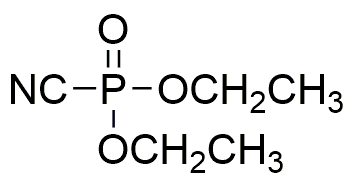Diethyl cyanophosphonate is widely utilized in research focused on
- Agricultural Chemistry: This compound serves as a key intermediate in the synthesis of various pesticides and herbicides, helping to improve crop yields and protect plants from pests.
- Pharmaceutical Development: It is used in the synthesis of phosphonate derivatives, which can act as antiviral and anticancer agents, providing researchers with valuable tools in drug discovery.
- Material Science: Diethyl cyanophosphonate is employed in the production of flame retardants and plasticizers, enhancing the safety and performance of various materials.
- Organic Synthesis: This chemical acts as a versatile reagent in organic reactions, allowing chemists to create complex molecules more efficiently, which is crucial for developing new compounds.
- Environmental Chemistry: It is used in studies related to the degradation of organophosphorus compounds, helping researchers understand their environmental impact and develop safer alternatives.
General Information
Properties
Safety and Regulations
Applications
Diethyl cyanophosphonate is widely utilized in research focused on
- Agricultural Chemistry: This compound serves as a key intermediate in the synthesis of various pesticides and herbicides, helping to improve crop yields and protect plants from pests.
- Pharmaceutical Development: It is used in the synthesis of phosphonate derivatives, which can act as antiviral and anticancer agents, providing researchers with valuable tools in drug discovery.
- Material Science: Diethyl cyanophosphonate is employed in the production of flame retardants and plasticizers, enhancing the safety and performance of various materials.
- Organic Synthesis: This chemical acts as a versatile reagent in organic reactions, allowing chemists to create complex molecules more efficiently, which is crucial for developing new compounds.
- Environmental Chemistry: It is used in studies related to the degradation of organophosphorus compounds, helping researchers understand their environmental impact and develop safer alternatives.
Documents
Safety Data Sheets (SDS)
The SDS provides comprehensive safety information on handling, storage, and disposal of the product.
Product Specification (PS)
The PS provides a comprehensive breakdown of the product’s properties, including chemical composition, physical state, purity, and storage requirements. It also details acceptable quality ranges and the product's intended applications.
Certificates of Analysis (COA)
Search for Certificates of Analysis (COA) by entering the products Lot Number. Lot and Batch Numbers can be found on a product’s label following the words ‘Lot’ or ‘Batch’.
*Catalog Number
*Lot Number
Certificates Of Origin (COO)
This COO confirms the country where the product was manufactured, and also details the materials and components used in it and whether it is derived from natural, synthetic, or other specific sources. This certificate may be required for customs, trade, and regulatory compliance.
*Catalog Number
*Lot Number
Safety Data Sheets (SDS)
The SDS provides comprehensive safety information on handling, storage, and disposal of the product.
DownloadProduct Specification (PS)
The PS provides a comprehensive breakdown of the product’s properties, including chemical composition, physical state, purity, and storage requirements. It also details acceptable quality ranges and the product's intended applications.
DownloadCertificates of Analysis (COA)
Search for Certificates of Analysis (COA) by entering the products Lot Number. Lot and Batch Numbers can be found on a product’s label following the words ‘Lot’ or ‘Batch’.
*Catalog Number
*Lot Number
Certificates Of Origin (COO)
This COO confirms the country where the product was manufactured, and also details the materials and components used in it and whether it is derived from natural, synthetic, or other specific sources. This certificate may be required for customs, trade, and regulatory compliance.


